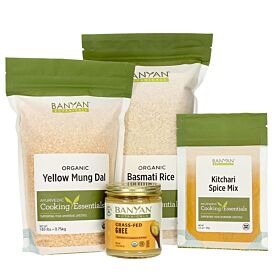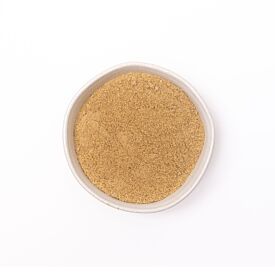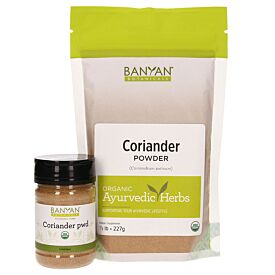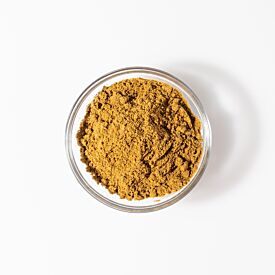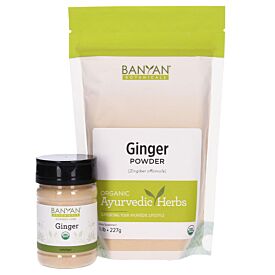What Is Kitchari & Why We Eat It for Cleansing
Kitchari (pronounced kich-uh-ree, and also spelled kichdi, khichdee, and khichri) is the traditional cleansing food of Ayurveda. It is a combination of split mung beans and white basmati rice with plenty of spices, depending on your constitution.
Amidst all of the modern diet trends happening today, this might seem like an unusual cleansing food.
Here are seven reasons why kitchari is a fabulous food for cleansing:
Kitchari Is Good for Everyone
Kitchari is balancing for all constitution types. (If you don't know your constitution, take the dosha quiz.)
While beans are typically not a food recommended for regular consumption for vata types—or for people experiencing vata imbalances—the split mung is easy to digest for even weak digesters.
Whole mung beans are oblong and green, but the mung dal used for cleansing is half the size (because they’re split, of course!). The green husk is removed, leaving them yellow.
When beans are split, they are called “dal” or “dahl,” so don’t get these confused with other dals, such as chana dal (split chickpeas), urad dal (split black gram), or masoor dal (split red lentils).
If you're thinking of becoming a parent, or are nursing a little one, you may wonder, "Can I do a kitchari cleanse while pregnant or nursing?" Traditional Ayurvedic cleansing is not recommended during pregnancy or while breastfeeding. However, it is okay to include kitchari in your diet, and if you want, you can still honor the spring and fall seasons by eating simple, whole foods and adjusting your daily routine to the seasonal transition.
Kitchari Is a Complete Protein
The combination of rice and mung dal provides all the amino acids needed to form a complete protein. Eaten on their own, each of these foods is missing one or more of the essential amino acids that our bodies are not able to make on their own.
However, together they make magic happen! The protein content of kitchari supports stable blood sugar levels so that energy and mental clarity are balanced during the cleansing process.
Kitchari Is Easy to Digest
White rice is traditionally used in kitchari because it is very easy to digest. Along with the split mung dal, kitchari is a food that is gentle enough for babies.
In fact, in Ayurvedic homes, kitchari is typically given to people who need to support their health, to the elderly, and to babies because it is so gentle.
Also, eating a monodiet of primarily just kitchari for several days offers the digestive system a rest by making the diet extremely simple.
Kitchari Is Nourishing Enough to Get You Through Your Day
Panchakarma (the traditional Ayurvedic cleanse completed under the care of trained practitioners), is done away from the home at a retreat center where meals are cooked for you and you receive specialized body work to facilitate the detoxification process.
Most people don’t have this luxury, and it is common to undertake a home cleanse while maintaining work and personal duties. With approximately 300 calories per bowl of kitchari (give or take, depending on the veggies you include), a kitchari cleanse is substantial enough to fuel you as you accomplish your day-to-day responsibilities.
Kitchari Improves Digestion
Agni, or the digestive fire (referred to as metabolism in Western terms), is considered in Ayurveda to be the golden key to all health.
Good agni means we are able to digest, assimilate, and absorb nutrients from our food. Weak or imbalanced agni means malabsorption and accumulation of ama (natural toxins).
Spices like ginger, cumin, coriander, fennel, and even salt encourage healthy agni. Because kitchari is made with spices that can be tailored to your constitution type, it nourishes and balances agni.
Kapha types benefit from all spices; vata types do well with most spices but should avoid very pungent ones, such as cayenne pepper; and pitta types can find balance with cooler spices like fennel and coriander.
Kitchari Loosens Toxic Buildup
Mung dal has an astringent (dry) quality. This astringency has a natural pulling action that helps to remove toxic buildup from the intestinal lining. This pulling action is much gentler than a harsh or abrasive scraping action that happens with raw or cold foods, especially raw vegetables.
According to Dr. Sunil V. Joshi in his book Ayurveda and Panchakarma, kitchari also liquefies ama during the second stage of digestion. This makes the ama easier to remove.
Kitchari Removes Natural Toxins from the Body
Once toxins are loosened and liquefied, it is essential that they get properly eliminated from the body. The split mung beans provide enough fiber (over 15 grams per 1-cup serving) to move these toxins through the GI tract and out of the body.

Make Kitchari Today
While kitchari is used for cleansing, it is also incredibly delicious, so don’t wait until your cleanse to try it! Not sure how to make it? Try this recipe.
Banyan makes it easy to get kitchari cleanse supplies. You can buy components separately, or, to keep it simple, you can order the Kitchari Kit, which includes mung dal, basmati rice, Kitchari Spice Mix, and ghee.
Make it as a special meal, topped with toasted sesame seeds, shredded coconut, or cilantro, and serve with a side of chutney. Try cooking the mung and rice together or separately, and add any variation of veggies to the cooking pot.
Enjoy, knowing all the benefits that kitchari brings!




